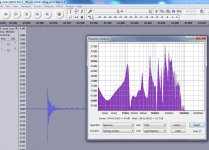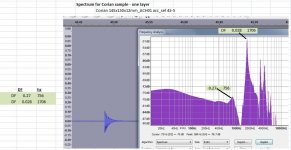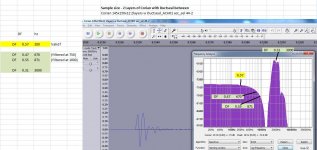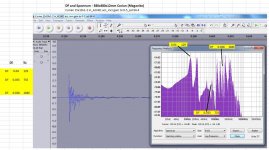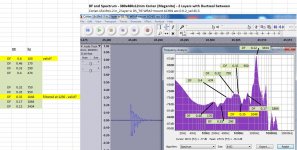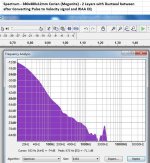The suggestion of a ultra thin tape having potential value within the assembly was what brought my thoughts to PTFE, especially as I have very recently investigated the material for another HiFi related project.
The PTFE Tape is made up from a mesh with an adhesive surface, or two adhesive surfaces to create the double sided version, the structure of the tape sounds familiar to other tapes under discussion in it most basic description.
There is a vast amount of information to be discovered, discussing the Visco Elastic Properties of PTFE, way too much for me to sift through and extract any information that might prove invaluable to this method under discussion for producing a structure.
Note: as there is experimentation ongoing and a history of exchanges of Layer Materials and Bonding Materials, I can see no real harm in bringing a material not discussed to the table, especially when the thickness being an absolute minimum was being suggested as a desirable property.
The PTFE Tape is made up from a mesh with an adhesive surface, or two adhesive surfaces to create the double sided version, the structure of the tape sounds familiar to other tapes under discussion in it most basic description.
There is a vast amount of information to be discovered, discussing the Visco Elastic Properties of PTFE, way too much for me to sift through and extract any information that might prove invaluable to this method under discussion for producing a structure.
Note: as there is experimentation ongoing and a history of exchanges of Layer Materials and Bonding Materials, I can see no real harm in bringing a material not discussed to the table, especially when the thickness being an absolute minimum was being suggested as a desirable property.
John,I can see no real harm in bringing a material not discussed to the table, especially when the thickness being an absolute minimum was being suggested as a desirable property.
Mike 56 and jcarr got my curiousity stirred up. I just tested some Corian on it's own, then with Ductseal, then Butyl tape. I haven't crunched any numbers, but first impression was that looks pretty good. I may try some other double sided tapes (much) later. Who sells the PTFE tape you mentioned?
H
A web search for Double Sided Teflon Tape will find the product for you.
It is available in various widths, and can be found at less than a mm in thickness, it might also be available in a sheet ?
It is available in various widths, and can be found at less than a mm in thickness, it might also be available in a sheet ?
Here's some Corian tests...
The first picture is a Shelf sized piece - 560mm x 320 mm x 12 mm thick. There's a big resonant peak at 100 hz and many others above that. I didn't test, but they will all surely be poorly damped. (If this had been 24mm thick, I expect most of those spikes would be higher in frequency.)
The second pic is a sample sized piece - about 150mm square x 12 mm thick. Much simpler eh? There's a peak at about 750. I measured the DF at 0.27 . Then there's another sharp peak at 1706 hz. 0.028 DF for this one.
The 3 rd picture is two layers pressed together with GB Ductseal blobs squeezed flat. The sharp peak is now a broader one at 3000 hz. DF is now 0.31. A few spot checks at lower frequencies look very good.
The 4th picture is two layers of Corian with 0.38 mm Butyl tape in between. (Contact cement was used on one side - this is not a double sided tape). The peak is now at 3304 hz. It's DF is now 0.12. The lower frequencies look good.
The Butyl tape was Henry Blueskin Butyl Flashing. It's not as stretchy as I had hoped. I suspect the "mastic" properties of the Ductseal do a better job on the ugly spike around 3000 hz.
I'm guessing a stretchier Butyl tape would have been more like the Ductseal on this 3000 hz peak.
I also think the Ductseal would do a better job than Blueskin on a plinth at cleaning up the multitude of spikes.
Hugh
The first picture is a Shelf sized piece - 560mm x 320 mm x 12 mm thick. There's a big resonant peak at 100 hz and many others above that. I didn't test, but they will all surely be poorly damped. (If this had been 24mm thick, I expect most of those spikes would be higher in frequency.)
The second pic is a sample sized piece - about 150mm square x 12 mm thick. Much simpler eh? There's a peak at about 750. I measured the DF at 0.27 . Then there's another sharp peak at 1706 hz. 0.028 DF for this one.
The 3 rd picture is two layers pressed together with GB Ductseal blobs squeezed flat. The sharp peak is now a broader one at 3000 hz. DF is now 0.31. A few spot checks at lower frequencies look very good.
The 4th picture is two layers of Corian with 0.38 mm Butyl tape in between. (Contact cement was used on one side - this is not a double sided tape). The peak is now at 3304 hz. It's DF is now 0.12. The lower frequencies look good.
The Butyl tape was Henry Blueskin Butyl Flashing. It's not as stretchy as I had hoped. I suspect the "mastic" properties of the Ductseal do a better job on the ugly spike around 3000 hz.
I'm guessing a stretchier Butyl tape would have been more like the Ductseal on this 3000 hz peak.
I also think the Ductseal would do a better job than Blueskin on a plinth at cleaning up the multitude of spikes.
Hugh
Attachments
This 1st screen shot is a piece of 12mm Meganite (= Corian by another supplier) cut to plinth size. Note all the resonant spikes with very poor damping.
The second shot is a second layer of Meganite Solid Surface pressed to the 1st with Ductseal. Not shabby at all! All the test frequencies up to 1000 hz measure about 0.35 DF or better. (Cats Squirrel seems to like 1000 hz and below as the relevant region on his Audioqualia site).
It's worth noting that Pyramid describes a similar combination of materials in one of his posts. I'd say he was on to something.
The pulse that was selected was a plastic hammer tip tap to the accelerometer side. The taps to the opposite side (or steel tip) may yield different results. Low DF materials seem to be sensitive about how I attach the accelerometer. In this case, it was Silicone grease and a small plastic tiewrap.
The second shot is a second layer of Meganite Solid Surface pressed to the 1st with Ductseal. Not shabby at all! All the test frequencies up to 1000 hz measure about 0.35 DF or better. (Cats Squirrel seems to like 1000 hz and below as the relevant region on his Audioqualia site).
It's worth noting that Pyramid describes a similar combination of materials in one of his posts. I'd say he was on to something.
The pulse that was selected was a plastic hammer tip tap to the accelerometer side. The taps to the opposite side (or steel tip) may yield different results. Low DF materials seem to be sensitive about how I attach the accelerometer. In this case, it was Silicone grease and a small plastic tiewrap.
Attachments
That poorly damped peak around 3400 hz looks imposing doesn't it? I don't think the cartridge is likely to pick it up.
The tests were all done by measuring acceleration. But, a MM or MC cartridge output is actually proportional to velocity. Then there's RIAA equalization applied by the Phono stage. I believe this screen shot represents the combined effect. The 3400 hz peak is way down in the mud.
The tests were all done by measuring acceleration. But, a MM or MC cartridge output is actually proportional to velocity. Then there's RIAA equalization applied by the Phono stage. I believe this screen shot represents the combined effect. The 3400 hz peak is way down in the mud.
Attachments
Hi Hugh
I don't carry out measurements like yourself and a few others who work with TT Damping.
I have a PTP Solid 9 with me for many years and the Supplied Plinth is a Sandwich of 32mm Corian between Two 8mm Corian Layers.
I wonder if the producer of the PTP Solid 9 has found this selection of materials to be their choice through testing.
The Company is based in Holland and would not have any complication sourcing a Densified Wood Board.
I don't carry out measurements like yourself and a few others who work with TT Damping.
I have a PTP Solid 9 with me for many years and the Supplied Plinth is a Sandwich of 32mm Corian between Two 8mm Corian Layers.
I wonder if the producer of the PTP Solid 9 has found this selection of materials to be their choice through testing.
The Company is based in Holland and would not have any complication sourcing a Densified Wood Board.
John,
That's interesting. Does it look like they have anything soft between the layers? Their web site just says solid corian.
Hugh
That's interesting. Does it look like they have anything soft between the layers? Their web site just says solid corian.
Hugh
I would say it is a tight compressed joint, but as a conjecture, the adhesive used might have a lowish modulus and enable a very limited freedom across the Tiers.
I have used Akemi Resin in the past, to bond Five Tiers, when the 9 Stone Monolith Granite Plinth was produced for a Garrard 401, this resin dries very hard and has little flexion if any.
The PTP Solid 9 even though weighty, is a lightweight in comparison.
I have used Akemi Resin in the past, to bond Five Tiers, when the 9 Stone Monolith Granite Plinth was produced for a Garrard 401, this resin dries very hard and has little flexion if any.
The PTP Solid 9 even though weighty, is a lightweight in comparison.
I'm a bit off topic with this one...
I was thinking way down the road that I'd try a Kevlar string and a big motor in comparison to the normal light synchronous motor and belts. Would it be reasonable to say that the Kevlar string is similar to a direct drive (Lenco style) for "prat" ? Or, should I plan on trying an Idler wheel too?
Anybody?
Hugh
I was thinking way down the road that I'd try a Kevlar string and a big motor in comparison to the normal light synchronous motor and belts. Would it be reasonable to say that the Kevlar string is similar to a direct drive (Lenco style) for "prat" ? Or, should I plan on trying an Idler wheel too?
Anybody?
Hugh
Hi Hugh
The Thread in the Link might be the closest to your thoughts on a design I have seen, quite a bit of work went into this model.
https://www.lencoheaven.net/forum/index.php?topic=39281.0
The Thread in the Link might be the closest to your thoughts on a design I have seen, quite a bit of work went into this model.
https://www.lencoheaven.net/forum/index.php?topic=39281.0
I wondered if Alucobond -- https://www.alucobondusa.com/ -- might be of interest in the CLD arena? It's thin but could be layered together, perhaps with mass loaded vinyl, or as one component with other materials.
Has anyone looked at it?
Has anyone looked at it?
That Mylar tape looks like it's worth a try. Hadn't thought about a sand filled base.Hi Hugh
The Thread in the Link might be the closest to your thoughts on a design I have seen, quite a bit of work went into this model.
https://www.lencoheaven.net/forum/index.php?topic=39281.0
Thanks!
I can ask. I don't have any here at the moment and the last time I held any was 30 some odd years ago. My brother found some being sold for scrap and bought some for other things. I'm eying the offcuts!
Mark
Mark
I use sand as well, its all done by iterative experiment and measurements as well as listening.I can ask. I don't have any here at the moment and the last time I held any was 30 some odd years ago. My brother found some being sold for scrap and bought some for other things. I'm eying the offcuts!
Mark
At the moment i have an Origin live turntable with my own radial tone arm. the OL sits on an avonite/MLV/avonite sandwich plinth which sits in a sand box.
The sand box sits on a wall shelf. My thought is that the sand box is the interface, trying to have no energy coming up and being the "sink" for any going down. the sand box addition lowered the low frequency noise levels.
My RTA has polished stainless steel tubular rails and these are sand filled, that measured better than both empty and blu tack filled rails.
Here attached for your interest (and perhaps amusement)
Does anyone else have similar measurements of the whole system result to compare? i have seen some measurements of well reputed commercial equipment and these better that by a way. it takes away the self delusion that says anything youve built sounds better than the one before, probably 50% go backwards!
Best, Mike
I found some cheap, used Corian to make an Audio shelf and tried my own advice. I used Blueskin Butyl Flashing and Contact cement to adhere the two layers. The Contact cement was a bad idea. The panel had a hollow sound and measured poorly.The 4th picture is two layers of Corian with 0.38 mm Butyl tape in between. (Contact cement was used on one side - this is not a double sided tape). The peak is now at 3304 hz. It's DF is now 0.12. The lower frequencies look good.
The Butyl tape was Henry Blueskin Butyl Flashing. It's not as stretchy as I had hoped. I suspect the "mastic" properties of the Ductseal do a better job on the ugly spike around 3000 hz.
When I pried it apart, I found the contact cement did not make contact in all areas - maybe 10 to 20% of the area. It did not go on smooth enough.
This may have also been the case to some extent on the smaller pieces I tested earlier.
Hugh
Apologies if this has been suggested but I'm a latecomer and not read every single post! It's very easy - and apparently intuitive - to be lured into the 'Mass is King' approach, but it ain't always so. One of the key points in vibration reduction is mismatching the acoustic impedances of the component and damping material to the greatest degree possible. Massive components can possess very high Q resonances that are notoriously difficult to damp. An alternative approach would be a lightweight stiff structure such as honeycomb composites. The resonances are necessarily pushed high up the frequency spectrum but the low mass enables easier damping and more effective use of materials. Furthermore there are materials which can be used for both the core and skins which are inherently self-damping. Win/win?
Last edited:
Hi MrKlinky,
I think you make a valid point. I'd heard similar advice regarding loudspeakers cabinets years ago.
I think the Rega P6 plinth fits what you describe. True? It's a foam core with phenolic layers. I saw one at a bargain price a year back and picked it up. It sounds very good. Different way of getting there.
I'm hoping this heavy, highly damped approached sounds better yet, but we'll see.
Hugh
I think you make a valid point. I'd heard similar advice regarding loudspeakers cabinets years ago.
I think the Rega P6 plinth fits what you describe. True? It's a foam core with phenolic layers. I saw one at a bargain price a year back and picked it up. It sounds very good. Different way of getting there.
I'm hoping this heavy, highly damped approached sounds better yet, but we'll see.
Hugh
- Home
- Source & Line
- Analogue Source
- DIY CLD Plinth Design--A measured Approach
